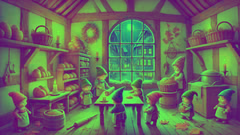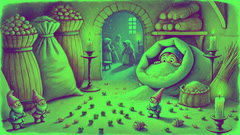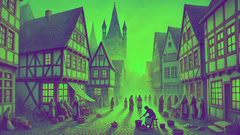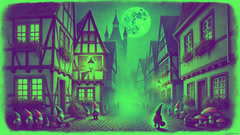Introduction
Nestled along the banks of the mighty Rhine, the medieval city of Cologne once shimmered with a peculiar kind of magic. Long before the spires of its grand cathedral pierced the sky and the cobbled lanes bustled with merchants and townsfolk, a whispered secret wove through the city’s winding alleys and half-timbered houses. There, beneath the moonlit eaves and behind shuttered windows, lived the Heinzelmännchen—tiny, enigmatic gnomes whose nimble hands and unseen kindness shaped the very heartbeat of Cologne. By day, the city hummed with laughter and prosperity; bakers’ shelves overflowed with golden loaves, shoemakers’ stalls gleamed with perfectly polished boots, and tailors’ racks glistened with stitched finery. Yet none could say just how such abundance blossomed from dusk to dawn. Rumor had it that the Heinzelmännchen, with pointed caps and bristling beards, crept out after sunset, completing every chore left unfinished by human hands. These nocturnal benefactors never asked for thanks or reward, slipping silently through kitchens and workshops, their presence betrayed only by the sweet scent of freshly baked bread or the soft glow of swept hearths. The legend grew with every generation, binding the people of Cologne with gratitude and wonder. But as with all magic, curiosity loomed—a temptation as old as time. For while the city thrived under the Heinzelmännchen’s gentle watch, there were those who yearned to uncover the truth behind these mysterious helpers. What secrets might be revealed if one dared to peek behind the veil? And what, then, would become of Cologne’s silent, sacred pact with its hidden guardians? So begins the tale of the Heinzelmännchen—the secret helpers whose wisdom, whimsy, and warning echo through Cologne’s storied streets even today.
The Midnight Miracle Workers
In the heart of old Cologne, where timbered houses huddled close like secrets in the night, the city’s heartbeat throbbed strongest after the last candle had been snuffed. While townsfolk drifted into slumber, soothed by the lullabies of distant church bells, the Heinzelmännchen awoke beneath floorboards and cellar stairs. No taller than a loaf of rye bread, each gnome wore a cap the color of autumn leaves and a tunic stitched from moss and spider silk. Their hands, though small, moved with purpose and astonishing speed.

By ancient pact—some whispered it was sealed by kindness shown to a wandering faerie—the Heinzelmännchen devoted themselves to the well-being of the city. They scurried through workshops, mended broken chairs, swept away sawdust, and set out fresh dough to rise in the bakeries. In shoemakers’ stalls, they stitched leather with perfect seams, transforming tattered soles into sturdy boots by dawn’s first light. Even the poorest homes awoke to the miracle of a full larder or a kindling-stacked hearth. Their magic was quiet, practical, and deeply woven into daily life.
To ensure their work went undisturbed, the Heinzelmännchen moved in utter silence. They left behind only the faintest traces—a wisp of flour on the counter, a pattern of tiny footprints on the sawdust floor. Sometimes, a child would claim to have glimpsed a flash of movement under the stairs, but parents would hush such talk, warning that to seek out the gnomes was to risk scaring them away forever. Gratitude, not curiosity, was the city’s unspoken rule.
With each passing season, Cologne flourished. Guilds grew rich, apprentices became masters, and the city’s fame spread along the Rhine. Travelers marveled at how swiftly work was done and how contented the townsfolk seemed. Rival cities scoffed, blaming luck or divine favor, but those who lived in Cologne knew their blessings were earned—and protected—by unseen hands. The Heinzelmännchen’s nightly labors became both a comfort and a mystery, their existence a lesson in humility. For to trust in what you cannot see, and to cherish what you do not fully understand, was the wisdom that kept the city’s magic alive.
Yet in the shadows, temptation stirred. Among the townsfolk, one heart burned with restless questions—a baker’s wife named Gertrude. She watched each night as her husband left dough to rise and found it in the morning baked to perfection. The urge to witness this miracle gnawed at her, growing stronger than the city’s age-old caution. Why should the gnomes remain secret? Was it not fair, she reasoned, to thank them properly or even learn their secrets? As her curiosity grew, so too did the seeds of change that would test Cologne’s pact with its midnight miracle workers.
Curiosity and Consequence
Gertrude’s longing to witness the Heinzelmännchen’s handiwork soon grew into a secret obsession. Every evening, as her husband Hans snored beside her, she would stare at the dim outline of the bakery below, imagining tiny figures bustling in the darkness. She yearned for proof that such wonders were real and wondered whether understanding their magic might bring even greater prosperity. In her heart, gratitude tangled with envy and a restless thirst for discovery.

One night, after weeks of careful planning, Gertrude made her move. She scattered peas across the bakery floor—she’d heard that gnomes were swift but easily tripped by round objects—and then she hid behind a flour sack, determined to keep her vigil. The hours dragged on, moonlight shifting across the tiles, until finally she heard the soft patter of footsteps—lighter than a mouse’s, yet strangely purposeful.
From her hiding spot, Gertrude saw them at last. The Heinzelmännchen crept from cracks in the walls and beneath cupboard doors, their eyes twinkling in the candlelit gloom. They worked with such grace and precision that Gertrude could scarcely breathe. One rolled dough into perfect crescents; another polished the oven until it gleamed. But as the first gnome slipped on a pea and tumbled to the ground, a soft gasp escaped Gertrude’s lips. The others froze. For a moment, silence hung heavy in the air.
The Heinzelmännchen looked around, their faces shadowed with fear and sorrow. They understood at once what had happened—the trust that bound them to Cologne had been broken. One by one, they vanished into cracks and shadows, slipping away into the night. Gertrude watched in horror as their magic faded from the room, leaving only a trail of peas and a sense of profound loss.
When morning came, the bakery was eerily still. The dough lay untouched, the floor unswept. Hans woke to find Gertrude pale and trembling, her eyes brimming with regret. Across the city, similar scenes played out: bakers, tailors, and cobblers awoke to discover their work left unfinished. The Heinzelmännchen had departed, their nightly miracles gone as suddenly as they had come.
At first, the townsfolk struggled to accept their loss. Shops stood empty, chores piled up, and laughter faded from the streets. Yet as weeks turned to months, a quiet resilience grew among the people. They rolled up their sleeves and worked longer hours, drawing on memories of the gnomes’ diligence and humility. Bit by bit, Cologne learned to thrive again—this time through its own efforts, guided by the wisdom the Heinzelmännchen had left behind.
A City Transformed: The Enduring Legacy
Life in Cologne changed after the Heinzelmännchen’s departure. The city’s early-morning quiet was now broken by the sounds of townsfolk rising before dawn—bakers kneading dough with tired arms, cobblers hunched over their benches, and tailors threading needles by candlelight. The effortless ease that once blessed their daily lives was gone. Yet in its place grew something no less precious: a renewed spirit of community and shared responsibility.

Families came together to help one another. Children fetched water and swept the stoops; neighbors traded bread for mended shoes; friends gathered in courtyards to share laughter after long hours of labor. The memory of the Heinzelmännchen’s silent kindness became a guiding star. Each person strove to match the gnomes’ devotion—working not just for themselves but for the city they loved. Slowly, a new prosperity took root, built on gratitude and unity rather than magic alone.
The story of Gertrude’s curiosity spread through Cologne as a gentle cautionary tale. Some resented her, blaming her for the loss of the gnomes’ help. But most came to see her as human—a symbol of both weakness and growth. Her regret was deep and lasting; she tended the bakery with even greater care, teaching her children to appreciate both the wonders and the limits of what could be known. She never forgot the look of sorrow in the Heinzelmännchen’s eyes or the lesson they had taught her: that some mysteries are gifts best left unopened.
As years passed, the legend wove itself into the city’s traditions. Each autumn, children would leave tiny loaves of bread and bowls of cream on their doorsteps, hoping to entice the Heinzelmännchen back. Though the gnomes never returned, the ritual kept their memory alive, reminding Cologne’s people that generosity and humility are treasures to be cherished above all else.
Cologne’s prosperity endured, shaped as much by hard work as by the wisdom of the past. The tale of the Heinzelmännchen became a cherished part of local folklore, celebrated in songs, festivals, and carvings on ancient doorways. Even today, in the quiet corners of the old city, some claim to hear faint footsteps at midnight—a gentle reminder that kindness leaves echoes, long after magic has slipped away.
Conclusion
The legend of the Heinzelmännchen lives on, etched into the very stones of Cologne. It’s a story that lingers in whispered bedtime tales, in the aroma of fresh bread at dawn, and in the gentle hum of neighbors lending hands to one another. The gnomes’ gifts were never just about effortless abundance; they were reminders that true magic flourishes when gratitude and humility guide our hearts. Though curiosity drove them away, their silent wisdom endures—teaching each new generation that not all wonders must be seen to be believed. In every act of unseen kindness and every unspoken cooperation, the spirit of the Heinzelmännchen thrives. So long as the city remembers to cherish mystery, to work together, and to honor what cannot be fully understood, Cologne’s enchantment will never truly fade.













